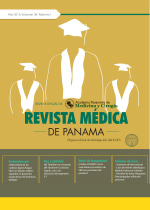Explorando un seminoma, encontrado en una ruptura testicular: reporte de caso.
Autores/as
DOI:
https://doi.org/10.37980/im.journal.rmdp.20211788Palabras clave:
seminoma, testículo, orquiectomía, traumaResumen
Dentro de los traumas testiculares, el cerrado representa la mayoría de los casos, y por lo general afecta a hombres de 15 a 40 años de edad. Presentamos un hallazgo de seminoma clásico luego de un trauma incidental con posterior exploración quirúrgica y orquiectomía radical de testículo izquierdo. Se resalta la dificultad de las herramientas de investigación como la ecografía testicular para apoyo del médico. Los seminomas suelen ser masas homogéneamente hipoecoicas. Las imágenes por resonancia magnética pueden ayudar a confirmar que una masa es intratesticular y proporcionar datos para la estadificación local. La tomografía computarizada proporciona información valiosa para la estadificación, incluida la presencia y el tamaño de los ganglios linfáticos retroperitoneales. El manejo es limitado. Sin embargo, el seminoma testicular se trata con orquiectomía inguinal radical y es altamente curable incluso en etapas avanzadas de la enfermedad. La mayoría de los médicos eligen la orquiectomía seguida de vigilancia para pacientes con enfermedad seminomatosa en estadio I y quimioterapia o radiación, seguida de una cirugía para el manejo de masas residuales, para pacientes con enfermedad en estadio II y superior. Destacamos la importancia de la sospecha clínica en estos tipos de pacientes jóvenes y tener una búsqueda activa ante estos traumas triviales.
Publicado
Número
Sección
Licencia
Derechos de autor 2021 Infomedic Intl.Derechos autoriales y de reproducibilidad. La Revista Médica de Panama es un ente académico, sin fines de lucro, que forma parte de la Academia Panameña de Medicina y Cirugía. Sus publicaciones son de tipo acceso gratuito de su contenido para uso individual y académico, sin restricción. Los derechos autoriales de cada artículo son retenidos por sus autores. Al Publicar en la Revista, el autor otorga Licencia permanente, exclusiva, e irrevocable a la Sociedad para la edición del manuscrito, y otorga a la empresa editorial, Infomedic International Licencia de uso de distribución, indexación y comercial exclusiva, permanente e irrevocable de su contenido y para la generación de productos y servicios derivados del mismo. En caso que el autor obtenga la licencia CC BY, el artículo y sus derivados son de libre acceso y distribución.






